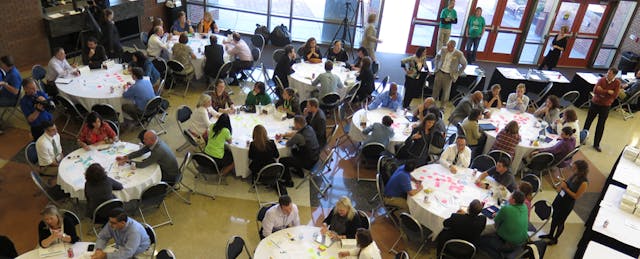“Considering my Saturdays are one of the very few downtime I have each week, I’d come to this event if it were held once a month,” extolled Patrick Blake, a science teacher of 18 years at Ritenour High School who painstakingly creates his own resources and lesson materials.
Blake and several hundred teachers and administrators devoted their precious Saturday to the EdSurge Tech for Schools Summit in St. Louis, held at Ritenour High School on Oct 17-18. They were there to engage with and learn 37 edtech companies, selected by local educator judges, whose products could help make their jobs more manageable--and fun.
This was our sixth such event and--we’re pleased to report--the first held at a school.
And what a school. Ritenour truly has one of the most impressive public high school campuses that the EdSurge team has seen: In addition to the awe-inspiring (or possibly stage fright-inducing) auditorium with a 3,700-square-foot stage, the school also boasts a state-of-the-art New Media Convergence Center, with a fully decked-out radio station and television studio, a $1.25 million project made possible thanks to a $50 million local bond passed in 2008. (It’s the only high school radio station in Missouri licensed by the Federal Communication Commission.)

“It’s essential to get students to create, whether it’s a radio broadcast, a televised update of the news, or even online portfolios,” said Jane Bannester, who teaches at the New Media Convergence Center. “We had so much student interest that we’ll have to expand the program.”
Kids certainly are ready--and able--to use technology smartly to learn. It’s time for the adults to play catch up.

What Did You Say?
Kristen Swanson, Senior Director of Research at BrightBytes, kicked off the Friday administrator workshop with a daring question: What percentage of your teachers feel rewarded for integrating technology? The simple answer: not very many. It’s a sad reflection that’s consistent with what her team has uncovered in districts around the country: 43% of teachers do not report feeling rewarded at all.
One St. Louis area administrator shared: “We have our [teacher] rockstars, and we have our rocks. The challenge is in turning the rocks into rockstars.” This process ultimately requires a deeper relationship between educators, explained Rob Landers, District Technology Coordinator at School District of Washington. “It takes a leap of faith for teachers to experiment and be okay with failure. They need a closer relationship with administrators to be comfortable making that jump.”

There’s also plenty of room to tighten up communications between educators and entrepreneurs--a fact the EdSurge workshop spotlighted during a classic game of telephone. Both parties crafted a pitch, whispered it around the table and realized how mangled the message became, often to hilarious effect. “A lot of the fluffy language disappears and only the core message remains,” said Jacob Klein, co-founder of Motion Math.
Moving Past Stuck
St. Louis districts clearly have an appetite for technology. “The first stages of innovation are the easiest as there are a number of hungry teachers and leaders that will jump into the fray and support the idea of an innovation ecosystem,” explained Robert Dillon, director of technology and innovation at Affton School District. “We had built this early coalition, and it was thriving, but we were seeing a bit of a contraction and a loss of momentum as individuals dealt with the true structural barriers of innovation that come from the overall scale of the ecosystem not being large enough.”
The Summit brought a “new set of energy and a fresh set of energy into the mix,” says Dillon. Both teachers and techies learned from one another. “There was never a sense that the edtech innovators felt that they had arrived with their product or service,” recalled Dillon. “I often forget the power of the single conversation. Personally, I was able to cultivate a number of ideas that I'll be able to spread throughout Affton and beyond.”

“The interplay between tech coordinators and teachers was a delight,” said Adam Geller, co-founder of Edthena. He observed that many administrators, upon checking out a tool, were asking teachers for another perspective. “There was a chain reaction between administrators, head of professional development and teachers, who all questioned the product in different ways.”
Games were a draw for Jenny Bernstein, a social studies and arts teacher from Signal Hill School District, IL, who raved about Pixel Press. “I’m intrigued by the ability to have students draw their own games. It’s something that could work in summer programs,” she commented. An administrator noted with glee the potential of data tools like Schoolzilla and Kickboard: “Our teachers often see data as a task, not a tool.”
One of the most provocative conversation went to Steve James, Director of Sales at SP Controls, who “had one woman come up and ask me, ‘Tell me why I wouldn’t buy this software.’” Certainly sounds like one of those trick questions investors throw during startup pitches.

Empowering Kids
The Summit also elevated another key voice when it comes to technology: students. Chris McGee, Chief Connecting Officer of ConnectED Learning, deftly moderated a panel of 13 high school students to capture their candid thoughts on how they actually use technology. “A lot of people are worried about technology. But it can help you more than it can hurt you if you use it the right way,” said Annalise.
Students were adamant that they should play a role in helping teachers smartly adopt technology. “You have to let the student speak,” advised Chase. Another student added: “Keep an open mind and learn with your students.”

Teachers agreed. “Too many teachers and districts are making purchasing decisions without the kid’s perspective,” admits Ann Bolzenius, a teacher at District of Washington.
Jaime Casap, education evangelist at Google, focused his closing keynote on how technology and information has fundamentally changed how learning works. Instead of going through Dewey decimals and microfiches at the local library (before it closes), anyone today can access the world of knowledge at their fingertips. “How kids think and how we think learning works are very different.”

He continued: “The purpose of education is to prepare kids for jobs that don’t exist.” No longer should we ask them, “What do you want to be?” That question, he believes, implies that today’s job will exist two decades from now. A better question, in his mind, is: “What problem do you want to solve?”
It's a challenge that encourages kids to develop their mindset around thinking creatively and taking action. “Kids don’t want our world. They want to build their own.” Casap’s children, like many others, are honing their building skills, one block at a time, in games like Minecraft. It won’t be long until they carry those problem-solving talents into the real world.


